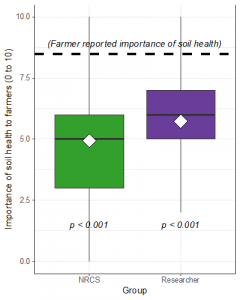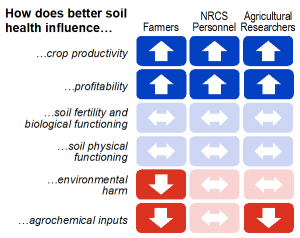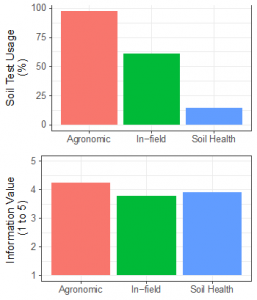How do we collectively conceptualize “soil health” and how do we use that to guide meaningful research and extension?
How would you define “soil health”? How do you think others would define it? You have likely seen people using the term “soil health” to refer to concepts that you personally might not personally think fit the definition of soil health. You are not alone! Inconsistent definitions of soil health can make communication difficult and even confusing.
Having run into this problem many times, a group of us from The Ohio State University recently set out to get a better grasp of how we as an agricultural community perceive and assess soil health. Specifically, we wanted to know 1) how high of a priority soil health is to farmers? 2) how are we all thinking about soil health?, and 3) how useful do farmers find current soil health tests? We used a survey to target three groups within this community: soil health scientists at land grant universities, NRCS employees, and row crop farmers in the Midwest. We received a total of 265 complete, usable responses from 12 states: Ohio, Michigan, Indiana, Illinois, Iowa, Wisconsin, Minnesota, Nebraska, North Dakota, South Dakota, Kansas, and Missouri.
How important is soil health to farmers?

Figure 1. Perceived farmer prioritization of soil health. Dashed line represents farmer-reported prioritization of soil health. Paired comparisons of each group to farmers was performed using Kruskal-Wallis test.
First, we wanted to know how important soil health is to farmers and whether non-farmers accurately perceive that importance. On an importance scale from 1 to 10 (with 10 being the highest), farmers ranked soil health as an 8.5 out of 10 (Figure 1)—really important! However, both of our non-farmer groups underestimated how important soil health was to farmers. On average, NRCS personnel and agricultural researchers estimated that farmers rank soil health at 4.9 out of 10 and 5.7 out of 10, respectively. These non-farmer groups gave a wide range of responses to this question, ranging 0 to 10 for NRCS and 2 to 10 for researchers. More importantly, our results show that soil health has broad, often unrecognized levels of support among farmers.
Are we all thinking about soil health in the same way?
One of the more important considerations for communicating about soil health is whether there is agreement about the effects of improving soil health. We asked our survey respondents to link to soil health to 6 broad themes.

Figure 2. Group level differences in soil health perceptions. Blue indicates a positive relationship and red indicates a negative relationship. Faded, two-way arrows indicate that respondents thought that soil health both influenced and was influenced by that production component. All relationships shown here had > 80% agreement within each group.
Generally, all three groups agreed on the relationship between soil health and most of the themes (4 out of 6; see Figure 2). All three groups agreed that improvement in soil health can increase crop productivity and overall profitability, but that the relationship between soil health and soil fertility and the relationship between soil health and soil physical functioning was complex and flowed in both directions. Two specific areas—the effect of soil health on environmental harm and the effect of soil health on agrochemical inputs (fertilizers, herbicides, etc.)—differed slightly across groups. While farmers and researchers both agreed that improved soil health decreased agrochemical inputs, NRCS employees reported that the relationship went in both directions; improved soil health decreased agrochemical inputs and agrochemical inputs decreased soil health. Similarly, more than 80% of farmers thought soil health reduced environmental harm, whereas more than 80% of NRCS personnel and agricultural researchers not only perceived this relationship, but also indicated that environmental harm reduced soil health. These group-level differences show that even in the broadest, most general groupings, there are differing perspectives on the effects of improved soil health.
An example of how to use and implement these findings: if a researcher wants to communicate with farmers about the benefits of soil health, an impactful messaging strategy would emphasize the effect of soil health on agrochemical inputs. Both researchers and farmers are more likely to see this relationship as one-directional and therefore more straightforward (Figure 2). For concepts with broad agreement (e.g. crop productivity and profitability), successful and straightforward communication across groups is more likely.
How useful are current soil health tests for farmers?

Figure 3. Farmer-reported soil test usage (top) and the perceived value of information from each type of soil test (bottom).
Increasingly, lab-based soil health tests are used to assess soil health, often supplementing other more conventional soil testing methods. We wanted to determine how frequently soil health tests are used and how valuable the users found the results from those tests, relative to other forms of soil testing. Specifically, we compared traditional agronomic tests, in-field soil tests, and soil health testing. Agronomic soil tests (e.g., pH, organic matter, extractable nutrients, etc.) were the most commonly used, with nearly all farmers having recently used them (Figure 3). In-field soil tests (e.g., shovel, feel, etc.) were the next most common form of soil test with over 50% usage, followed by soil health tests, with only 15% usage by farmers. Farmers generally found the information from these tests equally valuable, scoring about a 4 out of 5 on a 1-5 information value scale (with 5 the highest value). Thus, while soil health tests are infrequently used by farmers, those that do use them find them valuable. This suggests that the barrier to their use is not one of value, but is likely other considerations, such as cost or availability.
Final Thoughts
This survey has several key takeaways for researchers, extension agents, and soil testing facilities.
- First, it highlights the perhaps-undervalued potency of soil health as a framing and communication strategy around certain aspects of production (e.g., crop productivity and profitability). However, the literature connecting soil health indicators to these outcomes is (so far) somewhat sparse.
- Therefore, another key insight this provides us is the necessity of selecting and connecting soil health measurements to commonly-perceived soil health outcomes.
- Lastly, our results show that there are potential barriers to farmers using soil health testing that should be investigated and addressed. This essential step would likely involve extensive collaborations across multiple stakeholder groups, including commercial soil test laboratories.
Author: Jordon Wade , Margaret Beetstra, and Steve Culman, The Ohio State University